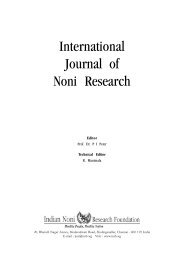International Journal of Noni Research - Noni Family
International Journal of Noni Research - Noni Family
International Journal of Noni Research - Noni Family
You also want an ePaper? Increase the reach of your titles
YUMPU automatically turns print PDFs into web optimized ePapers that Google loves.
9 Intl. J. <strong>Noni</strong> Res. 2007, 2(1-2)<br />
P. Rethinam et al. <strong>Noni</strong> (Morinda citrifolia L.) - the Miracle Fruit - a holistic review<br />
Style : Exerted just beyond the corolla, terete throughout, not fleshy, capitate,<br />
glabrous; lobes absent or 2, ovate, oblong or linear, stigmatic surface located<br />
at style apex. Exert.<br />
Ovary : Inferior, 2- or 4- locular, narrowly obovoid; placenta reduced, ovules<br />
basally inserted, 1 per locule.<br />
Fruit : Densely clustered globose syncarp, fleshy. The <strong>Noni</strong> fruit is initially<br />
green in colour, turns yellow and the ripened fruit has unpleasant, insipid,<br />
foul or fetid odour (Francis, 2003).<br />
Seeds : Vertical, medium-sized, ovoid to obovoid or reniform; wings absent.<br />
Planting Material Production<br />
<strong>Noni</strong> is relatively easy to propagate from seeds, stem, or rooted cuttings and<br />
air layering . The preferred methods <strong>of</strong> propagation are by seeds and cuttings<br />
made from stem verticles (Nelson, 2001). Micro propagation using tissue<br />
culture is the other possibility <strong>of</strong> multiplication <strong>of</strong> planting material.<br />
Seeds : Seeds are extracted from the fruits and sowing can be done<br />
immediately after extraction. Hot and wet conditions are required for maximum<br />
germination. Under green house condition or raising seedling in the<br />
warmest part <strong>of</strong> land provide better environment for better seed germination<br />
(Singh et. al ., 2007). Seeds after drying in shade for 3 or 4 days can be<br />
stored in air-tight containers at room temperature. However, the storage<br />
studies are yet to be taken up (Singh et. al., 2007).The treatment with hot<br />
water at 40 oC for a period <strong>of</strong> 24 hours and a treatment with sulphuric acid<br />
at 50 % concentration for 5 minutes was able to overcome the seed<br />
dormancy (Ponnaiyan and Vezhavendan, 2005). The highest germination <strong>of</strong><br />
seeds were obtained where the seeds were nicked and then treated Gibberllic<br />
acid (GA) at 1000ppm for a period <strong>of</strong> 24 hours (Ponnaiyan and Vezhavendan,<br />
2005). Seeds treatment with hot water at 40 oC combined into sea weed,<br />
(Ascophyllum riodosum) Biozyme and the treatment with sulphuric acid 50%<br />
for 5 minute combined with Biozyme were able to break seek dormancy as<br />
well as better health and vigour to the germinated seedlings (Muthu and<br />
Mathan 2006). Seed germination studies <strong>of</strong> soaking seeds for 24 hours with<br />
Gibberlic Acid (GA) at 800 ppm increased the germination percentage to<br />
91.06% as against mere water treatment (51.4 %). The inter action <strong>of</strong> seed<br />
soaking and treatment by GA 800 ppm increased high percentage <strong>of</strong> seedlings<br />
and number <strong>of</strong> leaves (Singh and Rai (2005) and Singh et. al., 2007). Pre<br />
treatment <strong>of</strong> seeds with Na HClO3 (5% available chlorine for 30 minutes)<br />
increased the germination up to 84%. However, the growth parameters were<br />
good in KNO3 (150 ppm)(Sudha and Singh, 2007).








